Three Transfer Functions
Transfer function measurement allows us to characterize the system as a whole or subdivided into parts.
The standard signal flow is mix console (our electrical input reference) to signal processor to speaker system (our acoustical output measured by a mic).
It’s easy to visualize the transfer function measurement between console and microphone. If we see a peak we can add a dip at the equalizer. But here’s the twist. Once we have started turning knobs on the equalizer we no longer know who is responsible for a peak or a dip. Did the loudspeaker system in the room cause it, or is it something we did on the EQ?
Once the filters go in we lose the evidence for why we chose to put them there. This may seem like an obscure point but in my experience it is absolutely vital to know why every filter is selected. This is a major factor in minimizing the probability that we are doing stupid things – most notably over-equalization.
But how can we monitor the EQ itself? The key is to add a third measurement access point at the mid-point in the series connections: the signal processor output. This location is both an output (of the processor) and an input (of the loudspeaker system).
If we keep the console input reference the same and move the measurement probe upstream to the processor output, we will see just see the EQ alone. Conversely, we can isolate just the speaker system in the room (independent of the signal processor) by moving the input reference downstream to the mid-point and use the mic for the output.
These three measurement points have been integral to every generation of the Meyer Sound SIM platform. The three data points (EQ input, EQ output and mic) can be paired into three distinct transfer functions: Room (EQ out vs. mic), EQ (EQ in vs. EQ out) and Result (EQ in vs. mic). The Room transfer function shows the raw, unequalized response (even after it is equalized). The EQ response shows the EQ response (duh!), and the Result shows the combined effects of the speaker in the room and the applied EQ. Room shows us the problem. EQ shows the treatment, and Result shows whether we’ve achieved our goal.
It’s extremely helpful in practice to have this complete characterization. Of course in the old days it helped because it was the only way we could see the EQ response. Now we can just look at the control software.
But there’s more. The modern EQ is a full suite DSP, and can be doing all sorts of other things you might not see on the user interface. I like to see the response and not be surprised. The data shown in the room response contains only the loudspeaker in the room, and therefore complies with the laws of physics.
If I see a propagation time of 100 ms, I want to know if the loudspeaker is going through 100 ms of air or if it’s 90 ms of digital delay and 10 ms of air. This makes a big difference, because I expect a loudspeaker response to have some damage after 100 ms of air travel, but not after 10 ms. That is just a single example, but simply put, knowing the processor from the room helps keep us wise as to the physical reality of the room. DSP + acoustics = magic. Be careful of magic.
Primordial SIM
The experimental phase of SIM ran from 1984 to 1987. During this period our hardware was custom made and constantly evolving as we learned more. The gear consisted of the HP 3582, a custom two-channel interface to the sound system, a digital delay, and a measurement mic and preamp. Our “computer” was the HP 87, which ran a language called Basic and had a whopping 256 kilobytes (kB) of memory. How much data could we store in it: two entire responses (remember that each response took a whole series of 63 traces from the HP). The computer had only one function: store and retrieve data so we can make comparisons.
However, in 1987 we broke the multichannel barrier with the official introduction of SIM. We now call it SIM 1, but at the time we didn’t know if there would be a sequel. The analyzer was still the HP 3582 but we were set up to provide it with a lot more to measure. SIM 1 was fully multichannel. The standard system had an interface to measure 8 equalizer inputs, 8 equalizer outputs and 8 microphones. It could be expanded to 16 or even 24 though not many people did so (it was already 20 rack units).
The system also had a digital delay and a computer with an expanded role. The computer, the HP IPC was the master controller of the whole system. The analyzer, the delay line and the switcher interfaces were all driven by the IPC.
The capabilities of the system were unprecedented at the time: we could patch into the system and switch between multiple equalizers and measurement mics, store the data at 8 locations and be ready to compare them to another 8 sets of incoming live data. All told we had enough memory to store 16 sets of traces. The 1 megabyte (MB) memory card cost $1,200 at the time!
The multiple mic capability changed everything because now we could start to really see how a change in one processor setting or splay angle affected multiple locations.






